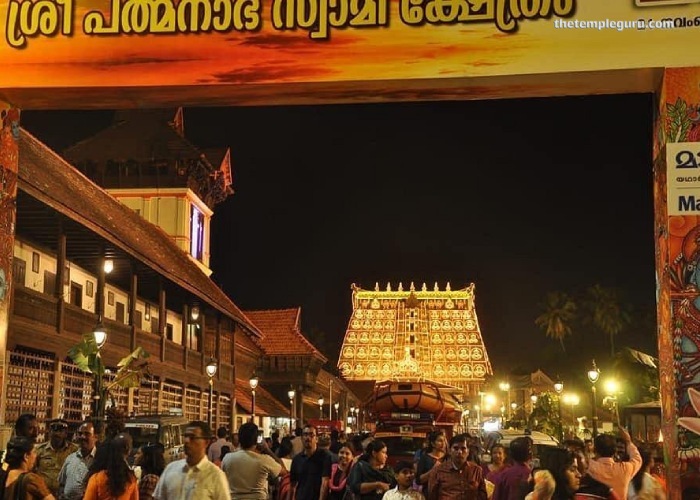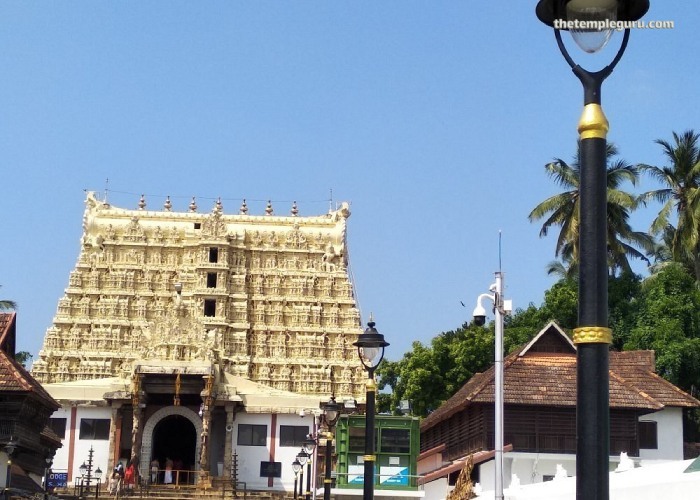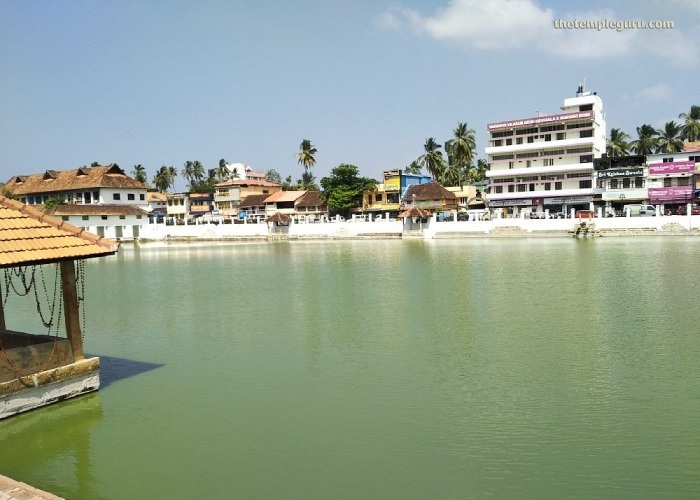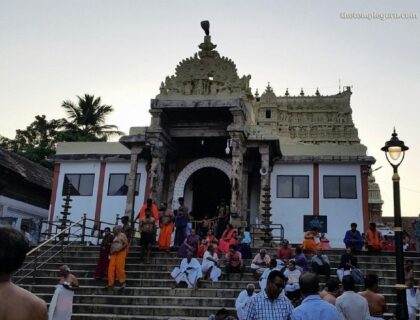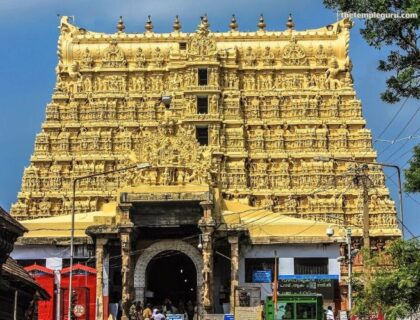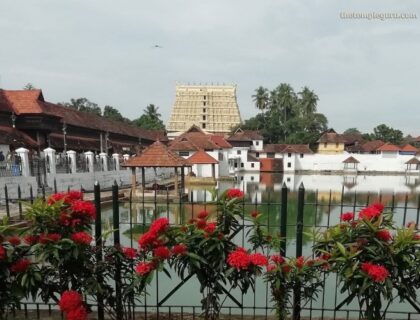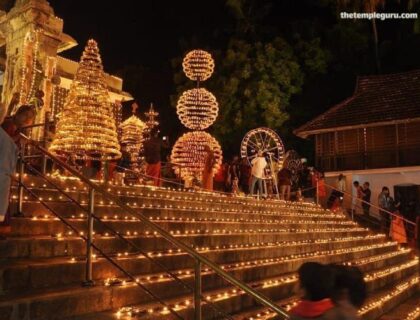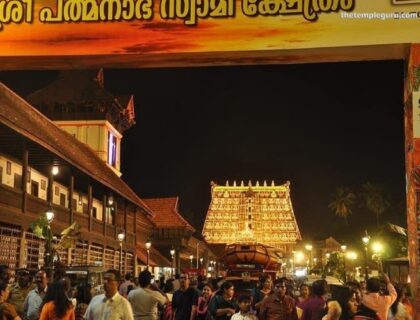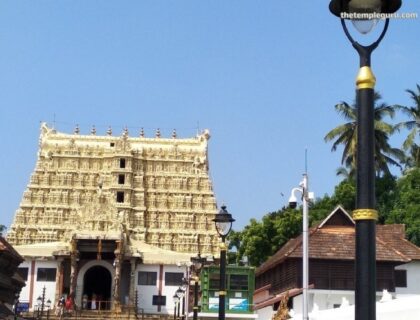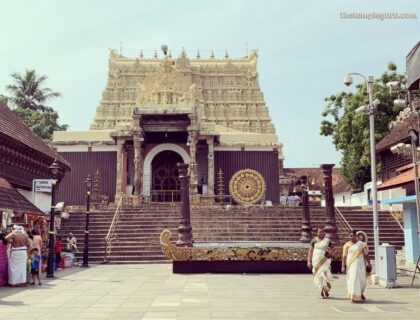Padmanabhaswamy Temple
The Shree Padmanabhaswamy Temple is a Hindu temple dedicated to Lord Vishnu located in Thiruvananthapuram city in the Indian state of Kerala. It is commonly regarded as the richest Hindu temple in the world. In Malayalam and Tamil, the name ‘Thiruvananthapuram’ translates to “The City of Ananta” (Ananta being a form of Vishnu).
Padmanabhaswamy Temple architecture is a blend of Kerala and Dravidian styles, with a 100-foot tall gopuram (ornate entrance gate). Inside, in the main shrine, an 18-foot idol of the major god sits in the Ananthasayanam posture on Adi Shesha. Padmanabhaswamy Temple is one of the world’s costliest temples and one of Lord Vishnu’s 108 sacred temples. The temple has a long history, and its hidden treasure has occasionally attracted people’s interest.
Legend about Padmanabhaswamy Temple
The temple’s foundation date is unknown. However, popular belief holds that it was founded around 5,000 years ago. The palm leaf records at the temple state that it was founded by sage Divakara Muni Vilwamangalam. Padmanabhaswamy Temple Kasaragod, also known as Ananthapura Lake Temple, was where he performed rituals. That temple is said to be Anantha Padmanabhaswamy’s original seat (moolasthanam).
According to legend, Lord Vishnu appeared as an orphan child before sage Vilwamangalam. The sage felt sorry for him and let him stay at the temple. He offered his assistance in the temple’s daily operations. Vilwamangalam treated the child harshly one day, and the child fled into the forest.
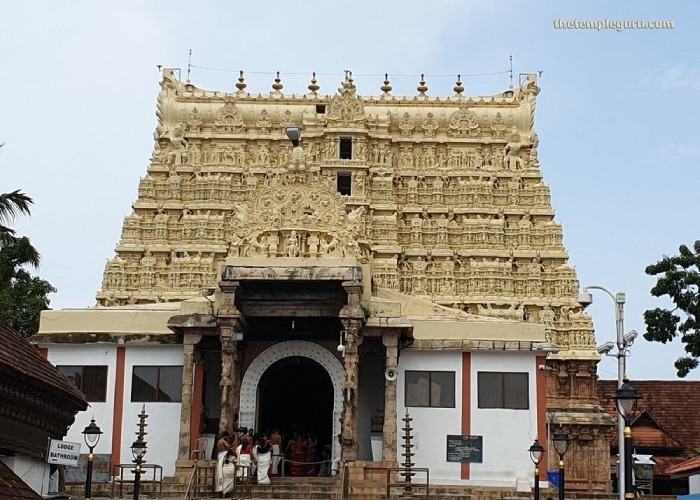
Vilwamangalam, on the other hand, quickly realised that the boy was Lord Vishnu himself. So he went in search of him. He followed him into a cave that led to Thiruvananthapuram today. The youngster then vanished into a mahua tree. The tree fell and transformed into Lord Vishnu, who was lying on the thousand-hooded serpent Adi Shesha.
In this Ananthasayanam posture, Lord Vishnu’s size extended up to 8 miles, and sage Vilwamangalam requested that he condense to a smaller size. Even though Lord shrank, the sage couldn’t see him completely. Because of the trees, he could only see Lord Anantha in three parts: the face, the stomach area, and the feet. The doors of Trivandrum’s Shri Padmanabhaswamy Temple depict the large idol in the same way that the sage saw the Lord.
History of Padmanabhaswamy Temple
Although the exact date of construction is unknown, the temple was first mentioned in the 9th century. The roof of the sanctum sanctorum was later repaired during the 15th century, according to palm leaf records. Around the same time, the Ottakkal Mandapam on the premises was built. Around the mid-17th century, King Anizham Thirunal Marthanda Varma ordered major temple renovations.

The sanctum sanctorum was rebuilt, and the old idol was replaced by a katu-sharkara statue made of 12,008 shaligram stones and various herbs. The statue’s construction was completed by 1739. The king also constructed the stone corridor, gate, and flagstaff. Then, in 1750, during the Thrippadidanam ceremony, he dedicated his kingdom to the Lord. King Karthika Thirunal Rama Varma constructed the pillared outdoor hall – Karthika Mandapam – in 1758. The large Anantha Shyana mural was created in 1820, during the reign of Queen Gowri Parvathi Bayi.
Another significant event in the history of Sree Padmanabhaswamy Temple occurred in 1936, during the reign of Chithira Thirunal Rama Varma. He drafted the Kshethra Praveshan Vilambram (or Temple Entry Proclamation), which allowed Hindus of all castes and creeds to enter the temple.
Architecture of Padmanabhaswamy Temple
Sree Padmanabhaswamy Temple Trivandrum is notable for its intricate stone and bronze work. The architecture is a fusion of Dravidian and Kerala styles, and the temple is similar to Thiruvattar’s Adi Kesava Perumal temple. Even the deities, lying in a reclining position, appear similar.
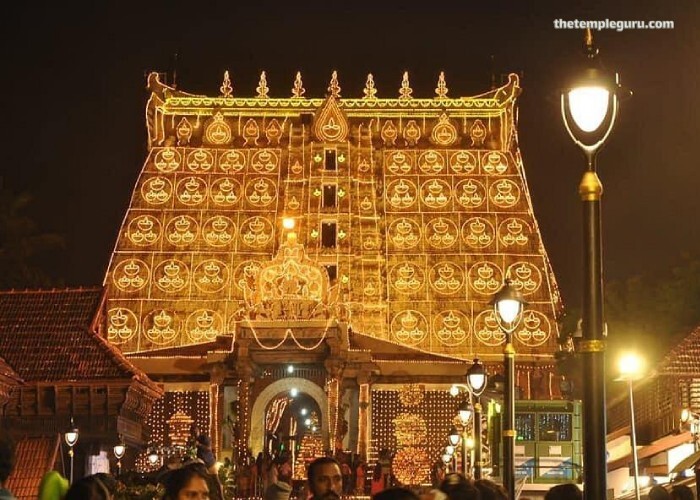
The first structure you will notice is the magnificent seven-tiered high gopuram, which is carved with intricate designs. The interior features a large corridor supported by beautifully carved stone pillars and sculptures of various Hindu deities. Beautiful murals adorn the temple’s walls and ceilings throughout. Sri Padmanabha reclines on Adi Shesha, whose hoods form an umbrella over his head, inside the sanctum. The sanctum has three doors through which you can see Lord Padmanabha’s reclining 18-foot idol.

Padmanabha sits on the serpent Anantha or Adi Sesha in the Garbhagriha. The serpent has five hoods that point inward, representing contemplation. The deity’s right-hand rests on a Shiva lingam. Vishnu’s consorts are Sridevi-Lakshmi, the Goddess of Prosperity, and Bhudevi, the Goddess of Earth. Brahma appears on a lotus that emanates from the deity’s navel. The deity is composed of 12,008 saligramams. These saligrams are from the banks of the Gandaki River in Nepal, and certain rituals were performed at the Pashupatinath Temple to commemorate this.
Shri Padmanabhaswamy Temple Treasure
Padmanabhaswamy Temple is the world’s richest temple. The assets are managed by the Padmanabhaswamy Temple Trust, which is led by the Travancore royal family. The treasure is a collection of valuable items amassed over thousands of years. It contains coins, statues, ornaments, and other valuable artefacts donated by rulers and traders from all over the world.
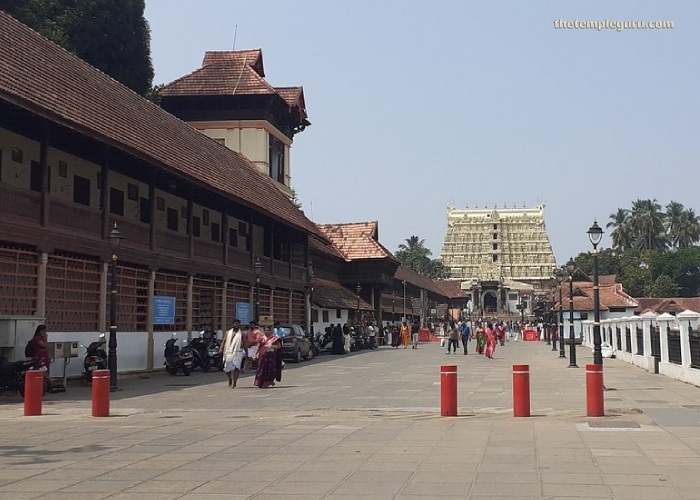
The list includes kings from South Indian kingdoms such as the Cheras, Pandyas, and Pallavas, as well as rulers from Greece, Jerusalem, Rome, and other traders who visited the temple. Donations also poured in from Europe’s various colonial powers. The temple has also been referred to as the Golden Temple in various literature due to its wealth.
Facts about Padmanabhaswamy Temple
- The Shree Padmanabhaswamy Temple is a Hindu temple, dedicated to Vishnu, in Thiruvananthapuram, the capital of the state of Kerala, India.
- Padmanabhaswamy Temple was built by Raja Marthanda Varma, one of the rulers of Travancore.
- The main deity is Padmanabhaswamy (Vishnu), who is enshrined in the “Anantha Shayana” posture, the eternal yogic sleep on the infinite serpent Adi Shesha.
- Padmanabhaswamy is the Travancore royal family’s tutelary deity. The temple’s current trustee is the titular Maharaja of Travancore, Moolam Thirunal Rama Varma.
- According to existing Tamil hymns from the seventh and eighth centuries C.E., the temple is one of the 108 principal Divya Desams (“Holy Abodes”) in Vaishnavism and is glorified in the Divya Prabandha.
- The palm leaf records reveal a lot about the treasures of Padmanabhaswamy Temple, as well as the gold and precious stones donated to the temple.
- For thousands of years, gold has been mined in and around Trivandrum. In addition, the area has served as a commercial hub. As a result, devotees brought gold to the temple as offerings.
- Many royal families in Southern India also kept their wealth safe in temple vaults.
- The enormous wealth piled over the centuries is stored in the numerous vaults within the temple premises. As per the estimates, the value is in several thousand crores.
- Moreover, many temples in Kerala were purchased under royal governance during the reign of Queen Gowri Lakshmi Bayi. The temples’ ornaments and other valuables were kept in the vaults of Padmanabhaswamy Temple. Many rulers sought refuge in Travancore, after which they donated their valuables to Lord Padmanabha.
- In June 2011, the Supreme Court of India directed the authorities from the archaeology department and the fire services to open the secret chambers of the temple for inspection of the items kept inside.
Secret Vault of Padmanabhaswamy Temple
- Mysterious vault B – The mysterious vault B is guarded by one of the Padmanabhaswamy Temple’s secret doors. Priests and scholars believe that mythological beings live in this chamber, which is guarded by Lord Vishnu’s avatar, Ugra Narasimha. In addition, the serpent image on the vault door denotes danger.
- The authorities attempted to open it under court orders but were unable to proceed beyond the ante-chamber. The petitioner’s untimely death, as well as the death of another observer’s mother, bolstered belief in the myth.
- According to legend, a group of people tried to open the vault a few decades ago and discovered it was full of cobras. Sages, legend has it, sealed the door with powerful Naga Paasam mantras.
Festivals in Padmanabhaswamy Temple
- Alpasi Utsavam: Alpasi is a 10-day festival celebrated in Malayalam during the month of Thulam. It takes place in October/November. The Anujna function kicks off with a flag hoisting ceremony (Kodiyettu) at the flag poles of Sree Padmanabhaswamy and Sree Krishnaswamy. Mannuneeru Koral, Mula Pooja, and Kalasam are among the other functions that will take place.
- Thiruvonam: Another major festival celebrated at Padmanabhaswamy Temple is Thiruvonam. The day is celebrated as Lord Padmanabha’s birthday. On this day, six pairs of wooden Onavillu (bows) are offered to the deities, according to a century-old tradition.
- Vinayaka Chathurthi: Also known as Ganesha Chathurthi, this festival is observed in the Malayalam month Chingam. During the worship, offerings are made to the Ganesha idol in the temple complex, and deeparadhana (aarti ceremony) is performed.
- Ashtami Rohini: Also known as Krishna Janmashtami, this day commemorates Sree Krishna Swamy’s birthday. Ashtami Rohini falls in the Malayalam month Chingam as well. This festival is marked by the creation of special decorations and the performance of Lord Krishna’s milk abhishekam.
- Navarathri Pooja: Navarathri is a 9-day festival held in September/October. In a grand procession, the idol of Goddess Saraswathi is also brought from Padmanabhapuram Palace to be worshipped alongside other idols. A large crowd of devotees gathers for the darshan.
- Maha Shivaratri: Maha Shivarathri is a festival commemorating Lord Shiva. It takes place in February/March. On this day, the Lord’s abhishekam is performed in the temple.
- Rama Navami: Lord Rama’s birthday is celebrated on Rama Navami. The festival takes place in March/April, and special poojas are held in his honour.
Dress Code And Rules of Padmanabhaswamy Temple
- Only Hindu believers are permitted to enter the temple.
- Prepare to arrive at the temple prior to the darshan times. The visiting hours are strictly enforced.
- Place your shoes on the rack near the main entrance.
- During your visit, adhere to the Padmanabhaswamy Temple’s dress code.
- Only dhoti and angavastram in white/off-white are permitted.
- The temple complex prohibits photography.
- Handbags are permitted inside. But leave your phone, camera, and other valuables in the locker room.
How to reach Padmanabhaswamy Temple
By Air: Trivandrum International Airport links the city to the rest of the world. There are direct flights from Indian cities such as Bangalore, Delhi, and Kochi. It also has international flights from Singapore, the Maldives, and cities in the Middle East, among others. The distance between Trivandrum Airport and Padmanabhaswamy Temple is approximately 4 kilometres.
By Railway: Trivandrum is Kerala’s capital and a cultural, academic, and information technology hub. As a result, it has regular trains from nearby towns and other parts of the country. Padmanabhaswamy Temple is about 2 kilometres from Trivandrum Central Railway Station.
By Roadways: Trivandrum is connected by road to nearby cities. Regular buses run from Coimbatore, Kochi, Madurai, and other cities. There are also buses from distant cities such as Bangalore and Chennai to Trivandrum. The bus stop is only 2 kilometres from the temple.
Also Read – Ashtabuja Perumal Temple
Location
Facilities
- Drinking Water
- Pooja Item Shops
- Prasad Shops
- Restaurants Nearby
- Resting Room







